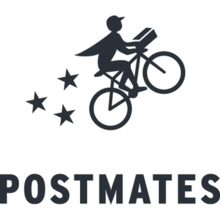Postmates
 | |
| Private | |
| Industry | Logistics |
| Founded | May 1, 2011 |
| Founder | Sam Street, Sean Plaice, and Bastian Lehmann |
| Headquarters | San Francisco, California, United States |
Area served | Select U.S. cities |
| Services | Goods delivery |
| Website |
postmates |
Postmates is a logistics company that operates a network of couriers who deliver goods locally. Postmates is closely compared to Uber because of its use of mobile phones to receive orders and dispatch delivery drivers.[1] As of December 2014, Postmates operates in 18 U.S. cities.[1] As of October 2015 their website lists more than 100 metropolitan areas.
The service is part of a category of businesses that rely on mobile phone applications and their Global Positioning System capabilities to quickly match inventories and consumer demand.[2] Postmates is an example of an on-demand company. Postmates co-founder Bastian Lehmann calls the company anti-Amazon, saying "Amazon comes along and builds a warehouse outside a city. We like to say the city's our warehouse. We try to understand the inventory available, hacking the city, and having a fleet of delivery people that distribute these inventories."[2]
History
Postmates was founded in 2011 by Sam Street, Sean Plaice, and Bastian Lehmann and is headquartered in San Francisco, California.[3]
In December 2014, Postmates opened its application programming interface to merchants to allow small businesses to compete for speedy delivery of consumer goods with larger companies such as Amazon.[1][4][5][6] The company announced in December 2014 that it had completed its millionth delivery and that it had over 6,000 drivers in its network.[7] In June 2015, Postmates announced that they had surpassed 2.5 million deliveries across 28 markets and expanded their fleet to 13,000 couriers.[8]
In September 2015, Postmates unveiled a revamped version of its app, dubbed Postmates 3.0, which features category discovery, delivery tracking, gifting and estimated delivery times.[9]
Funding
Postmates started getting outside funding before launch with 60k in seed funding from AngelPad. They later went on to receive 1.95 million in angel funding. In March 2013, the company raised $11 million in series A funding, led by Founders Fund. In February 2014, the company raised $16 million in series B funding, led by Spark Capital. In February 2015, the company raised $35 million in series C funding, led by Harmony Partners and Spark Capital. In June 2015, the company raised $80 million in series D funding from Tiger Global Management, Slow Ventures, and Spark Capital. [10] In September 2016, they raised $140 million in funding led by Founders' Fund. [11]
References
- 1 2 3 "Amazon Not as Unstoppable as It Might Appear". nytimes.com. Retrieved 2015-02-11.
- 1 2 "BBC News - Location services: How GPS delivery is changing shopping". bbc.com. Retrieved 2015-02-11.
- ↑ "About Postmates". postmates.com. Retrieved 2015-02-11.
- ↑ "Will Postmates Dominate Same Day Delivery with Its Open API? - Racked SF". sf.racked.com. Retrieved 2015-02-11.
- ↑ "Postmates, Powering On-Demand Logistics". blog.postmates.com. Retrieved 2015-02-11.
- ↑ "Postmates Is Launching An API To Let Third-Party Sellers Offer Local Delivery | TechCrunch". techcrunch.com. Retrieved 2015-02-11.
- ↑ "1 Million Deliveries Deep, Postmates Formally Launches An On-Demand API". techcrunch.com. Retrieved 2015-02-11.
- ↑ "We've Raised $80M, Led by Tiger Global Management". blog.postmates.com. Retrieved 2015-07-06.
- ↑ Dickey, Megan Rose (2015-09-21). "Postmates Unveils Revamped Platform, Announces 4 Million Deliveries". techcrunch.com. Retrieved 2015-11-06.
- ↑ http://blogs.wsj.com/digits/2015/06/25/postmates-raises-80-million-in-push-toward-1-deliveries/
- ↑ http://mashable.com/2016/10/31/postmates-funding-140-million/#uPRzAJqGgkqm
